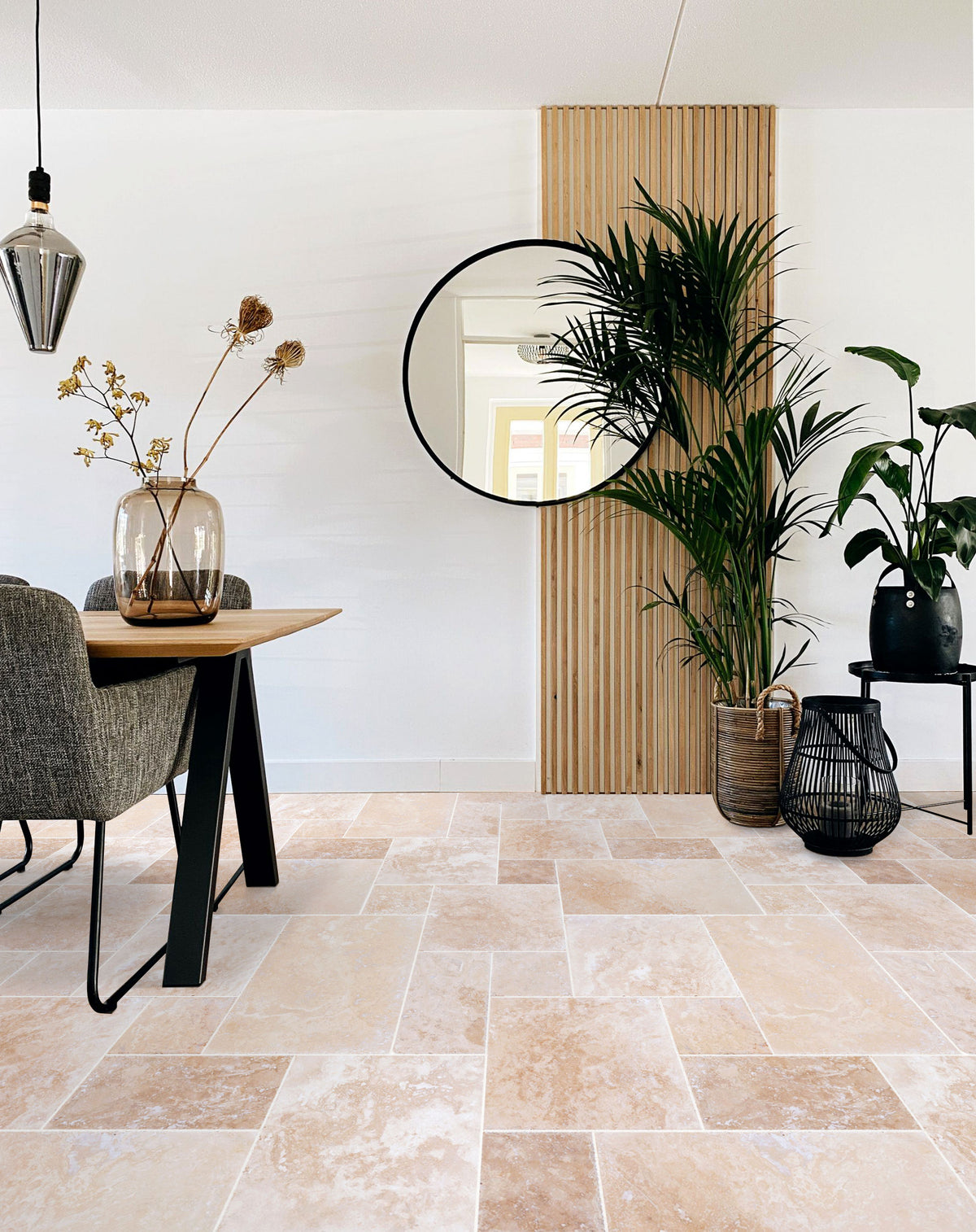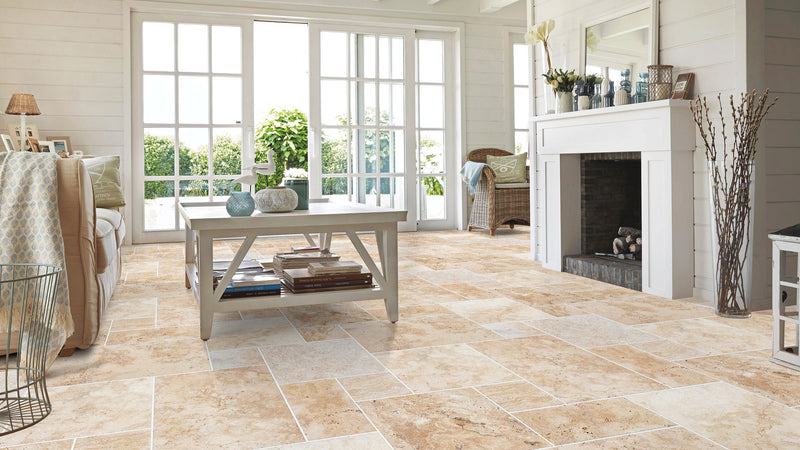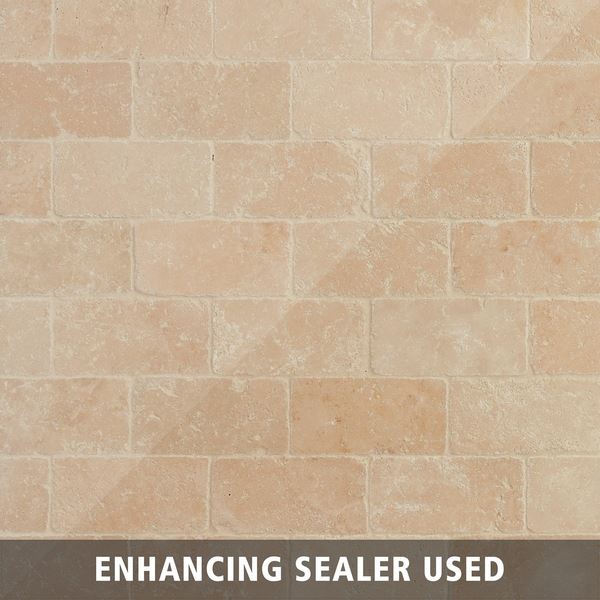Travertine tile flooring is a magnificent choice for both indoor and outdoor spaces. It’s not just about aesthetics; it’s about enhancing your living environment with natural beauty. In this guide, we’ll dive deep into what makes travertine tiles so appealing and how they can transform your decor. After all, who doesn’t want a home that feels both welcoming and luxurious?
What is Travertine Tile?
Origin and Characteristics
The stone is primarily found in regions with volcanic activity such as Italy, Turkey, and Mexico. Its porous nature gives it a distinct look, characterized by holes and pits, lending a rustic charm to any space.
Types of Travertine Tiles
- Filled Travertine: This type has the holes filled with resin or cement for a smoother finish.
- Unfilled Travertine: Retains its natural, textured surface with visible holes.
- Honed Travertine: Offers a matte finish, ideal for a sophisticated look.
- Polished Travertine: A glossy, shiny surface that enhances colors.
Benefits of Travertine Tile Flooring
Choosing travertine tiles for your home comes with a myriad of benefits. Here’s why you should consider them:

Durability
Travertine is incredibly durable and can withstand heavy foot traffic, making it suitable for various areas in your home.
Natural Beauty
Each tile is unique, offering a blend of colors, patterns, and textures that add elegance and charm to any space.

Versatility in Design
Whether you prefer a modern, contemporary, or rustic style, travertine tiles can seamlessly fit into your decor.
Temperature Regulation
Travertine stays cool underfoot, which is especially beneficial in warmer climates.

Eco-Friendly Option
Being a natural stone, travertine is an environmentally friendly choice, contributing to sustainable building practices.
Drawbacks of Travertine Tile Flooring
While travertine tiles come with many advantages, it’s essential to consider the drawbacks as well.

Porous Nature
The porous characteristic makes it susceptible to staining if not sealed properly.
Cost
Travertine can be more expensive than other flooring options, both in terms of material and installation costs.

Maintenance
Regular maintenance, including sealing and cleaning, is necessary to keep travertine looking its best.
Comparing Travertine to Other Flooring Options
| Feature | Travertine | Porcelain Tile | Hardwood |
|---|---|---|---|
| Durability | High | Very High | Medium |
| Maintenance | Moderate | Low | High |
| Cost | Moderately High | Moderate | High |
| Style Options | Many | Many | Limited |
| Comfort | Cool | Warm | Warm |

Where to Use Travertine Tile Floor
Travertine tiles can be used in various spaces around your home, both indoors and outdoors:
Indoor Applications
- Kitchens: Durable and beautiful, they are an excellent choice for kitchens.
- Bathrooms: Their water-resistant nature makes them ideal for bathrooms.
- Living Rooms: Create a warm and inviting atmosphere in your living areas.
- Hallways: The durability makes them perfect for high-traffic areas.
Outdoor Applications
- Patios: Transform your patio into a stylish outdoor living space.
- Pool Decks: Travertine is slip-resistant, making it safe around pools.
- Walkways: Use them to create beautiful pathways in your garden.
Choosing the Right Color and Finish
The color and finish of travertine tiles can dramatically alter your decor. Here are some popular options:
Popular Colors
- Beige: A classic choice that complements any design.
- Gold: Adds a touch of luxury and warmth.
- Brown: Perfect for a rustic or earthy look.
- Gray: Offers a modern and sophisticated touch.
Finish Options
- Polished: High shine, great for formal settings.
- Honed: Matte finish, ideal for casual and contemporary spaces.
- Brushed: Textured finish for a rustic feel.
Installation Process of Travertine Tiles
Installing travertine tile flooring can be a DIY project or handled by professionals. Here’s a basic overview of the process:
Preparation
- Measure the area to determine how much tile you’ll need.
- Prepare the subfloor, ensuring it’s clean, dry, and level.
Installation Steps
- Apply a thin layer of thin-set mortar.
- Lay the tiles starting from the center or a reference line.
- Use spacers between tiles for consistent grout lines.
- Once set, apply grout to fill the gaps between tiles.
- Seal the tiles to protect against stains and moisture.
Maintaining Travertine Tiles
Proper maintenance will help your travertine tiles retain their beauty. Here are some tips:
Cleaning
Use a pH-balanced cleaner specifically designed for stone tiles. Avoid acidic cleaners that can damage the surface.
Sealing
Apply a quality sealant after installation and reapply every 1-3 years, depending on the usage and location of the tiles.
Repairing Damage
If your tiles chip or crack, it’s essential to address the issue promptly. Use an epoxy filler for minor damage or consult professionals for significant repairs.
Personal Experience: My Journey with Travertine Tiles
When I first decided to renovate my kitchen, I knew I wanted something that would not only elevate the space but also stand the test of time. After doing extensive research, I chose travertine tiles. The installation was straightforward, and the finished look was nothing short of stunning! The coolness of the tiles during summer was an added bonus, making my kitchen a comfortable gathering space for family and friends.
FAQs About Travertine Tile Floor
Is travertine tile slippery?
Polished travertine can be slippery when wet, but honed or brushed finishes offer better traction, making them suitable for wet areas.
Can I use travertine tiles in my bathroom?
Absolutely! Travertine tiles are an excellent choice for bathrooms due to their water resistance and durability.
How do I prevent staining on travertine tiles?
Regular sealing and prompt cleaning of spills will help prevent stains from setting into the porous surface.
Are travertine tiles expensive?
While travertine can be pricier than other flooring options, its durability and aesthetic appeal offer great value over time.
How often should I seal my travertine tiles?
It is recommended to seal travertine tiles every 1-3 years based on the amount of foot traffic and exposure to moisture.
Conclusion
Travertine tile flooring is a beautiful and durable option that can add value and elegance to your home. Whether you’re renovating your kitchen, bathroom, or outdoor space, travertine tiles offer a unique combination of natural beauty and practicality. Armed with the insights from this guide, I hope you’re inspired to explore the possibilities of travertine in your own decor journey!